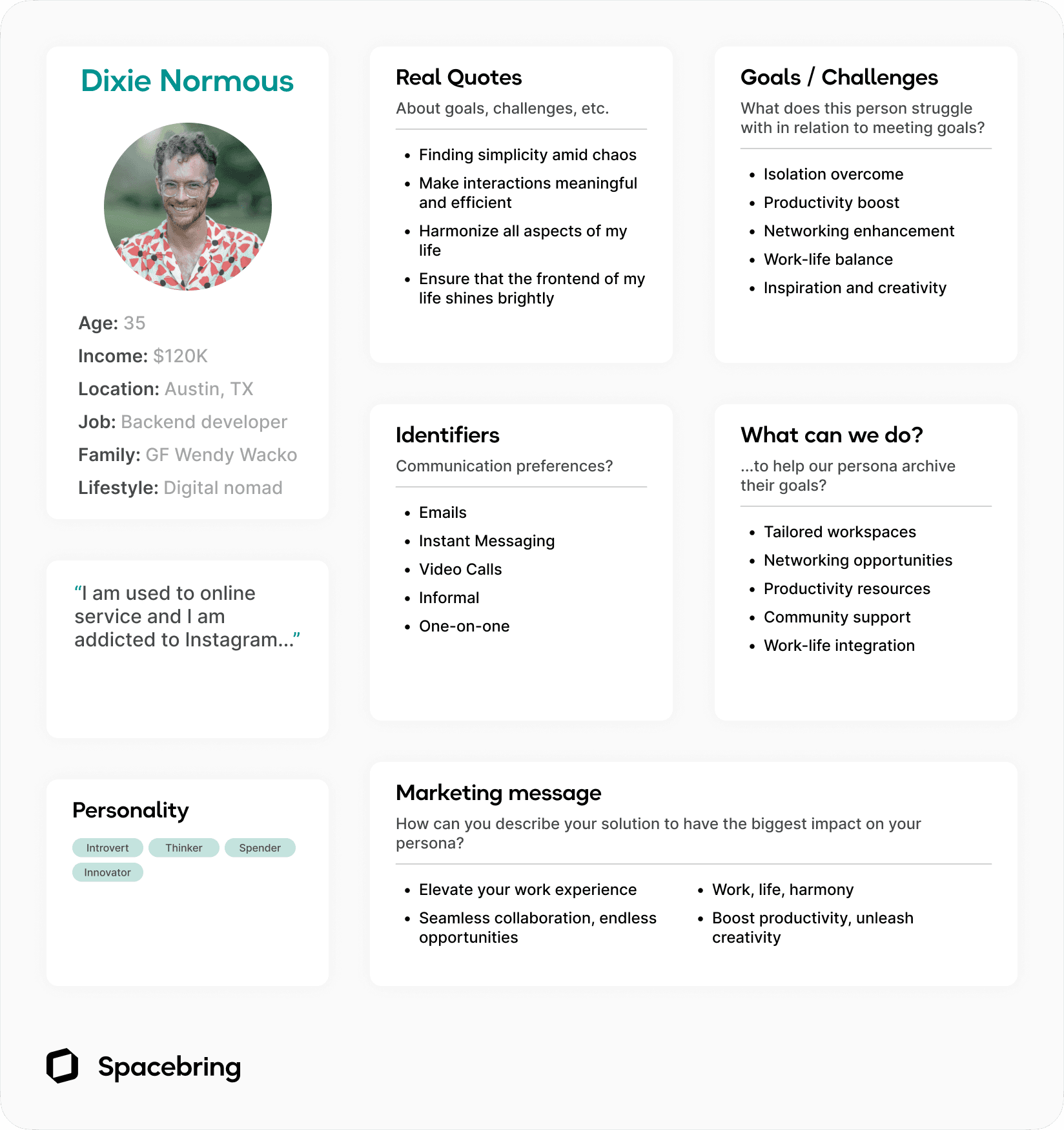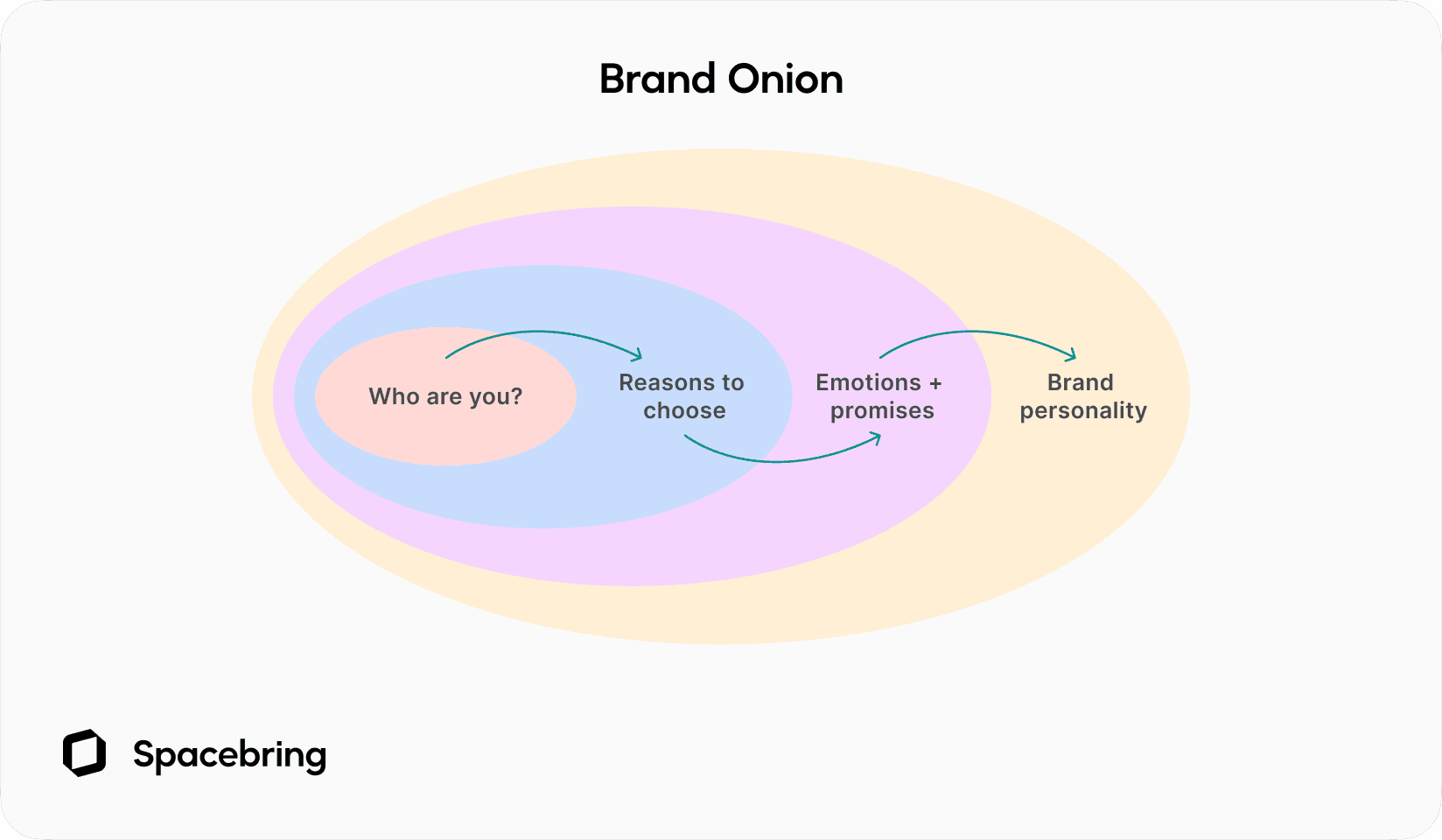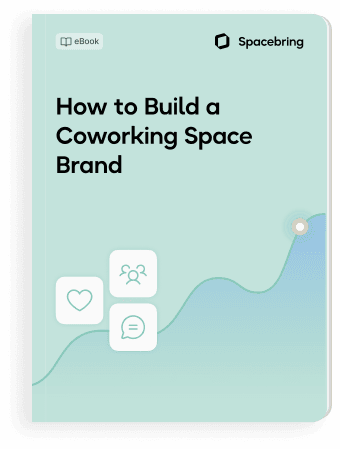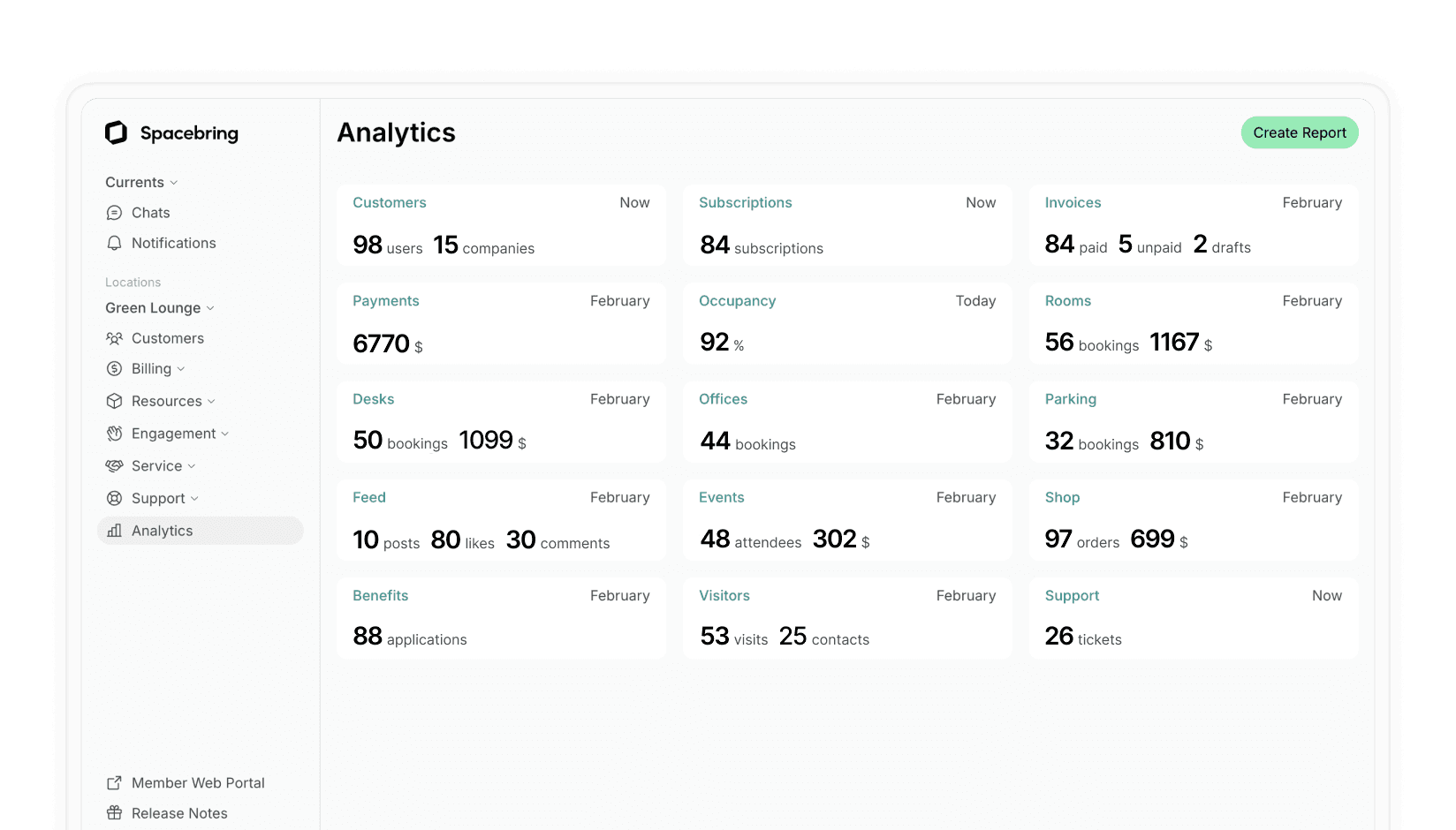Feeling lost in the world of marketing?
You're not alone! Many coworking space owners struggle to promote their businesses. Whether you're trying to attract new members, keep your current ones happy, or boost your online presence, effective marketing is key.
That's why we've created this guide. It's packed with practical tips and tricks to help you navigate the world of coworking space marketing. By the end of this guide, you'll have the tools and knowledge to attract and retain members and build a thriving community of professionals. Let's dive in!
Know Your Members: The Heart of Your Marketing Strategy
Imagine trying to sell shoes without knowing the size of your customers' feet. That's kind of what it's like marketing a coworking space without knowing your ideal member.
Who's Your Ideal Member?
Take a moment to think about the perfect person for your space. What kind of work do they do? What are their biggest pain points? What kind of atmosphere do they thrive in?
Here are some questions to get you started:
- Age and Gender: Are you targeting young entrepreneurs, seasoned professionals, or a mix?
- Occupation: Are they freelancers, remote workers, or small business owners?
- Work Style: Do they prefer quiet, focused work or collaborative, open-plan spaces?
- Values: Do they prioritize sustainability, community, or innovation?
10 Types of Coworking Space Members
Creating Member Personas
Once you've got a good idea of your ideal member, create a fictional character to represent them. Give them a name, age, job title, and personality. This will help you tailor your marketing efforts to their specific needs and interests.
For example, let's say your ideal member is a digital nomad. You might create a persona named "Alex the Adventurer." Alex is a 30-something who travels the world, working remotely from various locations. They need reliable Wi-Fi, comfortable workspaces, and a sense of community.

Download the customer persona template
Why Bother with Personas?
By understanding your ideal member, you can:
- Create targeted marketing messages: Tailor your content and messaging to resonate with their specific needs and interests.
- Choose the right marketing channels: Determine the best platforms to reach your target audience, whether it's social media, email marketing, or paid advertising with a social media virtual assistant.
- Measure your success: Track your marketing efforts using Power BI dashboard templates and see what's working and what's not.
Remember, the more you know about your ideal member, the more effective your marketing will be. So take the time to create detailed member personas and use them to guide your marketing strategy.
Your Coworking Space's Unique Story
Imagine your coworking space as a character in a story. What's its personality? What makes it special? That's your brand story.
Finding Your Brand Voice
Your brand voice is the tone and style you use to communicate with your members. Is it formal and professional, or casual and friendly? A consistent brand voice will help you connect with your audience on an emotional level.
Creating a Memorable Look
Your visual identity is how your brand looks. Think of your logo design, color palette, and typography. It should be eye-catching and reflect your brand's personality.
- A historic building? A vintage-inspired look might be perfect.
- A tech-focused space? A modern, minimalist design could be the way to go.

How to Shape Your Coworking Space Brand from Concept to Culture
Highlighting Your Unique Selling Points
What sets your coworking space apart? Is it your prime location, state-of-the-art amenities, or vibrant community? Here are some ideas:
- Location, Location, Location: If you're in a bustling city center or a quiet, inspiring neighborhood, highlight it.
- Cutting-Edge Amenities: Offer unique perks like podcasting studios where members can record content to increase TikTok followers, VR rooms, or meditation spaces.
- A Thriving Community: Foster a sense of belonging with regular events and networking opportunities.
By crafting a strong brand story and highlighting your unique selling points, you'll attract the right members and build a loyal community.

Striving for your coworking space to become a recognized brand?
Your Digital Front Door: A Strong Online Presence
Your website and social media are your digital storefront. They're the first impression potential members will have of your coworking space. So, let's make it a good one!
A Website That Wows
- Mobile-Friendly Magic: Make sure your website looks great on any device, from smartphones to tablets. Tools like Wix and Squarespace can help you create mobile-friendly websites without coding.
- Fast Loading Times: Optimize images and minimize code to reduce load times. Use tools like TinyPNG to compress images and Google PageSpeed Insights to analyze your website's performance.
- SEO Superpowers: Optimize your content using relevant keywords to improve search engine rankings. Utilize tools like Google Keyword Planner for keyword research, Yoast SEO, and ranking tools for content optimization. Create backlinks from reputable websites to enhance your website authority rating.
- Visual Appeal: Use high-quality photos and videos to highlight your space and its unique features. For video enhancement and editing, use tools like Canva or Adobe Premiere Pro.
- Social Media Integration: Make your website dynamic with embedded feeds. Embed Instagram feed to show posts and grow your audience.
- Clear and Simple: Ensure visitors can easily access information about pricing, membership options, and amenities. Utilize buttons and links to direct visitors to key information, and prominently display your contact details.

Don't have a website? No problem! Many coworking space management software providers, like Spacebring, offer pre-built landing pages. These pages are easy to customize and can help you attract new members quickly.
How to Create a High-Performing Website for Your Coworking Business
Social Media Savvy
- Choose Your Platforms Wisely: Focus on where your target audience hangs out. LinkedIn for professionals, Instagram for visuals, and Facebook for a broader reach.
- Share What Matters: Post regularly about your space, upcoming events, and community highlights.
- Engage with Your Audience: Respond to comments, answer questions, and join the conversation.
- Go Live: To connect with your community, host online events such as webinars or virtual coffee chats with tools like Instagram Live or Facebook Live.
By following these tips, you can create a strong online presence that will attract new members and keep your current ones engaged. Use social media reporting to track the performance of your posts.
Content Marketing: Your Secret Weapon
Content marketing is a powerful tool for attracting and engaging your target audience. By creating valuable content, you can position your coworking space as a go-to resource for entrepreneurs and remote workers. Incorporating RCS marketing can make your messages more interactive and visually appealing, helping you better connect with potential members.
What Kind of Content Should You Create?

- Blog Posts: Share your insights on topics like productivity, remote work, and entrepreneurship. If you need help getting started, an AI blog post generator can assist in creating well-structured content quickly.
- Webinars and Workshops: Host online events to educate and inspire. You could cover topics like time management, social media marketing, or public speaking.
- Case Studies: Highlight the success stories of your members to showcase the value of your coworking space.
- Infographics: Use visuals to break down complex information into easy-to-digest bites.
How to Boost Coworking Space Efficiency with AI
Getting Found Online
To make sure your content reaches the right people, you need to optimize it for search engines.
- Keyword Magic: Use tools to find keywords people are searching for.
- On-Page Optimization: Sprinkle those keywords naturally into your titles, headings, and content.
- Backlinks: Encourage other websites to link to yours. It's like getting a vote of confidence from the internet.
By creating high-quality content and SEO optimizing it, you'll attract more visitors to your website and generate more leads.
Dominate Local Search: Get Found in Your Neighborhood
Local SEO is like putting a spotlight on your coworking space for people in your area. By optimizing your local SEO, you'll show up higher in search results, attracting potential members who are just a stone's throw away.
As Maria Harutyunyan, Founder of Loopex Digital puts it: "Investing in local SEO not only increases visibility but also drives real foot traffic to your business, making it essential for growth in today’s market. 76% of people searching for nearby businesses visit one within a day, and 28% of local searches lead to a purchase."
Claim Your Spot on Google My Business
- Accurate Info: Make sure your business name, address, and phone number are correct and consistent everywhere online.
- Fill Out Your Profile: Add details like your business description, hours of operation, and photos of your space.
- Encourage Reviews: Happy members? Ask them to leave a review on Google. Positive reviews boost your local search ranking.
Build Strong Local Partnerships
- Team Up with Neighbors: Collaborate with nearby businesses. Cross-promote each other's services, organize joint events, or share each other’s digital business cards.
- Community Involvement: Get involved in local events and charities. It's a great way to build goodwill and brand awareness.
By optimizing your local SEO and building strong relationships with local businesses, you can attract more local members and create a thriving community.
Harness the Power of Word-of-Mouth Marketing
Word-of-mouth marketing is one of the most powerful tools in your marketing arsenal. It's like having a team of unpaid salespeople spreading the word about your coworking space.
How to Encourage Word-of-Mouth

- Happy Customers, Happy Referrals: Provide excellent service and create a positive experience for your members.
- Ask for Reviews: Politely ask satisfied members to leave reviews on Google, Yelp, and other relevant platforms.
- Showcase Success Stories: Highlight your members' achievements, whether it's a successful business launch or a career breakthrough.
- Build Relationships with Local Media: Pitch your coworking space as a potential story for local news outlets.
- Host Member Events: Organize networking events, workshops, and social gatherings to foster a strong community.
Complete Roadmap for Making Great Coworking Space Events
By focusing on creating a positive experience for your members and encouraging them to spread the word, you can harness the power of word-of-mouth marketing to attract new members and build a strong reputation for your coworking space.
Building a Thriving Community
A strong community is the lifeblood of a successful coworking space. By fostering a sense of belonging and connection, you'll attract and retain top-notch members.
How to Build a Thriving Community:

- Host Engaging Events: Organize networking events, workshops, and social gatherings to bring your members together.
- Create a Sense of Belonging: Design your space to encourage interaction and collaboration. Think comfy lounge areas, communal kitchens, and fun event spaces.
- Personalize the Experience: Get to know your members, their goals, and their passions. Offer personalized services like concierge help or event planning.
- Reward Loyalty: Create tiered membership plans or loyalty programs to incentivize long-term memberships. Provide escalating benefits like discounted renewals, exclusive resources, priority support, or special recognition based on membership duration or participation. Enhance loyalty rewards with custom merchandise, like branded apparel or personalized gifts, using print-on-demand for a tangible touch.
By prioritizing community, you'll create a space where people want to work, network, and grow their businesses.
20 Steps to Start, Grow, & Nurture Coworking Community
Knowing Your Numbers: Measuring Success
Marketing is all about making smart choices. To know what's working and what's not, you need to track key performance indicators (KPIs). These are like scorecards for your marketing efforts.
Here are some important KPIs to keep an eye on:
- Website Traffic: Track the number of visitors to your website, the pages they view, and the duration of their visits. This information helps you identify which content is engaging and where visitors may be losing interest. Google Analytics is a powerful tool for monitoring website traffic, user behavior, and conversions.
- Social Media Buzz: Monitor your follower growth, engagement rates (including likes, shares, and comments), and click-through rates (the number of times people click on links in your posts). This information helps you determine whether your social media presence is attracting and engaging the right audience. Utilize the analytics tools available on platforms such as Facebook, Instagram, and Twitter to effectively track these metrics.
- Lead Generation: Whether working with a lead generation agency or handling it in-house, you need to identify the sources of your leads, such as your website or social media, and track how many of these leads convert into paying members. This information will help you determine which marketing channels are the most effective. It’s also essential to understand your cost per acquisition (CPA), which is the amount spent to acquire a new member. Utilize a customer relationship management (CRM) tool like HubSpot or Salesforce to monitor your leads, opportunities, and conversion rates.
- Member Retention: Keep track of how many members renew their memberships and how many cancel (known as the churn rate). Understanding the reasons behind member cancellations, through surveys or interviews, can help you improve your space and services. Utilize tools like SurveyMonkey or Google Forms to conduct these surveys and gather feedback from your members.
- Net Promoter Score (NPS): Survey your members on how likely they are to recommend your coworking space to others, using a scale of 1 to 10. This will help gauge member satisfaction and pinpoint areas needing improvement. Consider using tools like Typeform for conducting NPS surveys.
Level Up Your Coworking Space with Smart Software
Imagine having a digital assistant that handles all the nitty-gritty of your coworking space. That's what coworking space management software can do.
Here's how it can supercharge your marketing efforts:
- Know Your Members: Keep track of their names, companies, contact details, and purchase histories. This helps you send personalized offers and tailor your space to their needs.
- Amplify Marketing: Send targeted messages, social media posts, and birthday wishes. All from one central location.
- Track Your Success: Monitor key metrics like member retention, revenue, and popular amenities. This data helps you make informed decisions.
- Streamline Operations: Let your software handle bookings, payments, and access control, freeing you up to focus on what matters most.

Bonus Tip: Use your software to upsell additional services like credit packages, private office rentals, snacks and beverages, or even branded merchandise. It's a win-win for both you and your members.
Generate recurring revenue and offer exceptional customer experience at your shared or coworking space
Spread the Word: Listing on Coworking Marketplaces
Think of these online marketplaces as virtual shopfronts for your coworking space. They connect you with potential members who are actively searching for workspaces. Here are some top platforms to consider:
- Coworker: A global giant, connecting potential members with a wide range of coworking spaces.
- Deskpass: A membership program offering access to a network of coworking spaces worldwide. Perfect for attracting remote workers and business travelers.
- LiquidSpace: A marketplace for all things flexible workspace. Businesses can browse, compare, and book workspaces through their platform.
Bonus Tip: Many coworking space management software solutions integrate with these marketplaces. This can save you time and effort by keeping your bookings in sync across multiple platforms.
Top 18 Marketplaces to Be Listed on
Wrapping Up
You've got a solid foundation for your coworking space's marketing strategy. By implementing these tips and tricks, you'll be well on your way to attracting and retaining members and building a thriving community.
Ready to take the next step? Book a demo call with a Spacebring product expert to learn how our software can help you streamline operations, enhance your marketing efforts, and attract more members.






